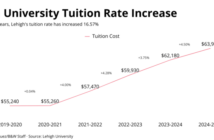Uriel Cruz Salgado graduated high school in spring 2018 with a plan and an admission letter to Lehigh University.
Nothing could stop Cruz from being the first in his family to attend college.
That plan might be cost-free. But by saying “yes” came potentially thousands of dollars in federal, institutional and private loans.
His reluctance to take out loans and debt is not surprising. The national average debt among first-generation students skyrockets at $30,700, while continuing-generation students are bound to an average of $28,000.
The distinction rests on doubt.
Without parental advice, “first-generation students are more likely to scrutinize the decision to incur debt,” according to a report published by the Journal of College Student Development.
Consequently, the burden of debt is more likely to turn them away from going to college.
Part of the problem is stigma, Cruz said. Many first-generation students think of loans as high-risk. Loans become debt, and the joy in rebate won’t ensure the ease in repayment.
Data from the Federal Reserve confirm what many fear: first-generation college students are almost twice as likely to be behind on their payments as continuing-generation college students — 12 percent versus 7 percent, respectively.
At Lehigh University, up the craggy hills stood rocky hindrances. For Cruz, to be first-generation is to have the word how perpetually poised on the tip of his tongue.
“First-generation students are typically self-reliant, which means we can be hesitant to ask for help,” Cruz said. “But when we want to, we don’t know how to.”
According to the National Center for Education Statistics, 30 percent of incoming freshmen are the first in their families to attend college.
Compared to continuing-generation students, relatively fewer first-generation students began at private non-profit four-year institutions — 23 versus 7 percent.
Lehigh Director of Admissions Bruce Bunnick said approximately 17 percent of students identify as first-generation in Lehigh’s class of 2023. This indicates a nearly 5 percent increase from the class of 2019.
Bunnick attributes this growth to the university’s deliberate efforts to attract more first-generation students.
“Recruitment of first-generation and historically underrepresented students remains an absolute priority,” he said. “We’re looking to diversify this campus and make it more reflective of the society that our graduates will inherit.”
Diversity knows no distance — its reach as significant as the dream of its patrons.
Two thousand six hundred and eighty five point two miles from Lehigh, Cruz grew up in Woodburn, Oregon, where his parents immigrated from Mexico in the mid-90s. His father owned a landscaping business, so the young Cruz would spend the balmy summer helping with the hard labor.
The sun was brilliant, the sky cornflower-blue.
Yet, he had no interest in following his father’s path. He was determined to be an astrophysicist, reaching for not only the stars, but planets and galaxies. No ifs, ands or buts.
“We’re trying to remove the intimidation from cost,” Bunnick said. “The return on the investment is significant over the span of one’s life.”
Approximately 58 percent of first-generation students at Lehigh are eligible for the Pell Grant — a federal subsidy that requires no repayment. The university applies this data as an input to define “low-income,” said Jennifer Mertz, director of financial aid.
Currently, 84 percent of first-generation students have applied for institutional need-based financial aid. Of those students, 98.6 percent have been awarded aid to meet their financial needs.
Financial need is met through a combination of grants, loans and work studies. Starting with the class of 2016, an annual cap of $5,000 is included in the financial aid package for all students with need.
“For students whose families’ annual income is between $75,000 and $150,000, the university caps loans to meet financial needs at $2,000 per year,” said Joann Deppert, assistant director of financial aid. “Loans to meet financial need are eliminated for students whose family’s total income is less than $75,000.”
Not included in this cap are loans outside of Lehigh’s financial aid package, which some first-generation students may use for books and living expenses.
Nationwide, 54 percent of first-generation students who haven’t obtained a credential said they could not afford to continue school, compared to 45 percent of continuing-generation students, according to the U.S. Department of Education.
“First-generation does not always mean low-income, but a lot of first-generation students are low-income,” said Vicki Jagdeo, coordinator of the first-generation residential community. “We don’t want to go into debt, and we don’t want to put that burden on our parents.”
Jagdeo was as ready as ever when her admission letter arrived. It arrived with relief, a rush of glee driven by how it feels to be the first.
It arrived after years of pressure while chasing an uncompromising goal, with every good grade leading up to an inevitable application.
It arrived two-fold — joy for Jagdeo and pride for her father, who never got to attend college before he immigrated to New York from the Caribbean.
“He always told me, ‘You have to go to college, or else you’ll end up like me, working long hours for the minimum wage,’” Jagdeo said. “If I’m not going to college, I’m letting him down.”
Yes: it arrived at certainty, despite her lack of guidance from someone who had gone through the experience.
So Jagdeo started from scratch.
“I’m trying to learn new concepts while also practicing them,” she said. “We all have to go the extra mile to get where everyone else is.”
Cruz estimates he will have taken out more than $26,000 in loans by the time he graduates in 2022.
“That pressure motivated me to do better,” he said. “Within my family, I’ve had the highest degree already. None of my parents got a high school degree. My dad didn’t complete middle school.”
To support himself, Cruz works 13 hours per week at a work-study job on campus and a few 5-hour shifts a month with Parking Services. On top of that, he’s also a barber part-time.
As of right now, he’s not intimidated by repayment. With or without loans, education comes first. It’s feasible, he said.
For Cruz, that perseverance — the one that brought him to college — will withstand and eventually revel in hardship the way a skipping stone bounces back every time it hits the water. No ifs, ands or buts.






Comment policy
Comments posted to The Brown and White website are reviewed by a moderator before being approved. Incendiary speech or harassing language, including comments targeted at individuals, may be deemed unacceptable and not published. Spam and other soliciting will also be declined.
The Brown and White also reserves the right to not publish entirely anonymous comments.
2 Comments
Loans ARE high-risk if your family doesn’t have the money to help you out, particularly if you’re borrowing to buy something you can’t easily turn around and sell. If you borrow for a house, you can sell the house. If you borrow for an education, you’d better hope there’s going to be jobs you can get that allow you to pay off your loans.
This is by no means a given, and I think that one of the things Lehigh’s going to find as they increase the 1st-gen proportion — and this is a healthy thing — is that it’s going to kick the placement stats some. Part of why Lehigh kids have been so successful is that they’re coming out of professional-business cultures at home and they have parents who can help them get those first jobs. This is not normally the case with 1st-gen students. So if you’re going to tell 1st-gen students “this is how much Lehigh students make when they graduate”, you’d really better be telling them about what, on average, 1st-gen students are making when they graduate, and give them a good long timespan on it. We’ve been in a good hiring environment lately; the same was not true ten years ago.
The job of fin aid should not be to assure first-gen students that loans are no problem. The job of fin aid should be to make sure that you aren’t in fact putting these kids in risky situations because it’s convenient for your stats. It’s also not kind to trivialize living expenses, which fall outside Lehigh’s cap: you’re talking about $60K there. If a first-gen kid’s FHI is below $75K, this kid should walk out of Lehigh with $0 in loans. There is no mommy and daddy there behind them to take care of expenses and buy that co-op and interview suit, and there is no mommy and daddy to send them to Mr. So-and-so for an interview. So, rich alumni and parents with degrees all over your household, you can save the complaints about how unjust such a policy would be.
Very informative and well crafted